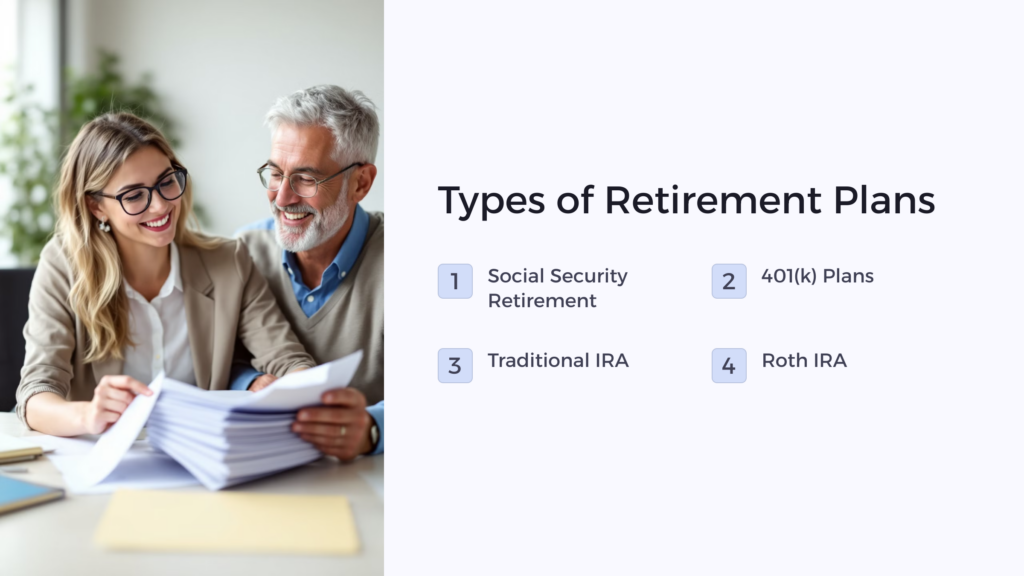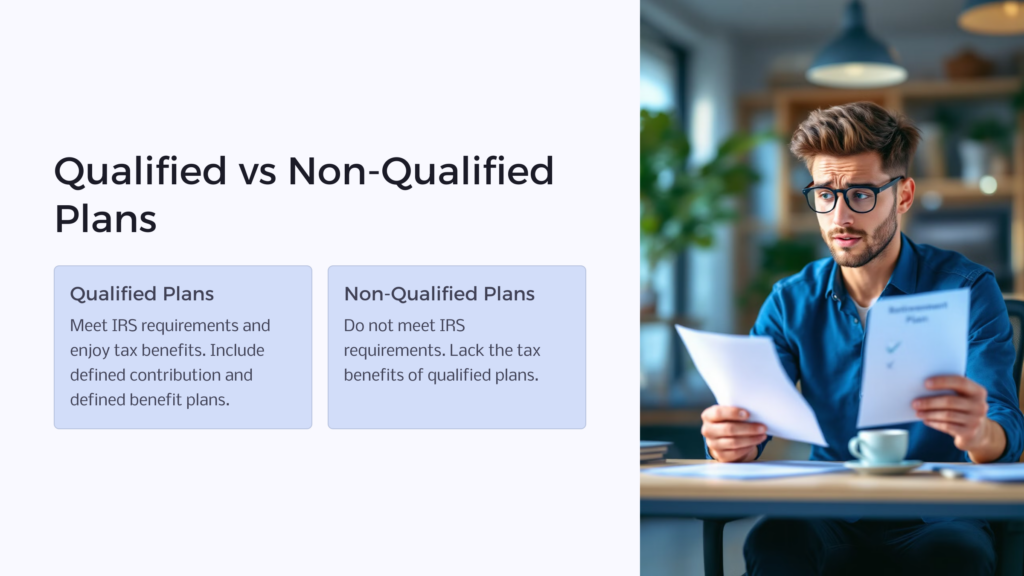Preparing for a comfortable and fulfilling retirement often can feel overwhelming. Gone are the days when an employee could rely on a generous company pension, supplemented by Social Security retirement benefits, as sufficient for meeting all her retirement income needs. Today, employees must put careful consideration into the type of retirement plan that makes the most sense. Before you start or change a retirement plan, it’s important to understand your options.

8 Types of Retirement Plans
- Social Security Retirement
- 401(k) Plans
- Traditional IRA
- Roth IRA
- 457 Plans
- SEP Plans
- Profit-Sharing Plans
- Employee Stock Ownership Plans
Retirement is likely to be the largest expense of your life – so it’s wise to start investing early and wisely to make sure your retirement income will be sufficient to support your lifestyle and health once you retire. Whether you’re looking forward to early retirement, or planning to work until full retirement age, careful consideration can go a long way toward making sure your retirement benefits are what you need for a comfortable retirement.
When it comes to choosing a retirement plan, consider your target retirement age, your life expectancy, and whether you plan on working after retirement. Keep in mind that you’re not necessarily limited to one choice when it comes to retirement savings. You can open more than one retirement account so that you unlock the various benefits associated with each type of plan. Each retirement plan option has its pros and cons, but you might find that each is easier to understand than you might think.
Social Security Retirement

While for most retirees, Social Security retirement benefits don’t compose their entire retirement income, Social Security provides a powerful supplement to other retirement accounts for as much as 96% of the American workforce. Since you’ve earned those benefits, it’s important to apply for them when the time comes. Throughout your working life, you pay social security taxes, which are used in the short term to pay benefits for those who are currently retired, those who receive disability benefits, surviving dependents of workers who have died and dependents of other beneficiaries. In turn, when you retire, the taxes the current workforce pays will be used toward your social security retirement benefits
Over your lifetime of work experience, you steadily earn social security “credits” based on the number of years you’ve worked. Once you accrue enough credits, calculated based on the year of your birth and the number of years worked, you can apply to receive Social Security retirement benefits. The earliest possible age to receive Social Security benefits is 62, but you also can wait and apply to receive your benefits as late as age 70. Your retirement benefit amount is based on your overall lifetime earnings – specifically, your highest 35 years of earnings.
As you calculate your retirement savings options, it’s smart to make sure you have at least a ballpark figure for how much income you can expect from Social Security retirement benefits so that you can factor that into your savings goals.
401(k) Plans
401(k) plans are tax-advantaged plans set up by employers to collect and invest money for their employees’ retirements. They are usually offered as part of a comprehensive employee compensation package. Classified as a “defined contribution plan,” a 401(k) plan allows employees to make contributions through payroll deductions, which not only add to the retirement account for the long term but also reduce taxable income for the short term since contributions are funded with pre-tax dollars. Contributions can be deducted from your paycheck, which helps automate your retirement savings behavior. This can be a plus for many people who might otherwise find it hard to save for retirement.
Many times, companies also will match employees’ contributions up to a certain percentage – for example, 3 to 5 percent of an employee’s salary. It’s always a good idea to contribute the maximum amount to your 401(k) that your employer will match. Make sure you understand the terms of your company match – sometimes companies “vest” their contributions over a period of years, which means that if you leave the company before its contributions are fully vested, you won’t be able to take them with you to a new employer. However, the contributions you make to your 401() are always yours and will travel with you when you leave an employer.
Your money is likely to grow fastest in a 401(k) plan, especially if your employer offers a matching contribution. 401(k) plans usually have a high contribution limit, both for the employee and the employer, so in that regard, they have the advantage over other plans that may offer a lower contribution limit.
One thing to keep in mind about a 401(k) plan is that the funds housed there are generally off-limits until you retire or unless you experience a triggering event. One exception to this rule is if your 401(k) plan features a loan option – in that case, you can borrow from your 401(k) account and then pay yourself back over roughly five years.
Traditional IRA
 A traditional Individual Retirement Account is a tax-favored retirement savings vehicle that allows you to invest in stocks, bonds, mutual funds, etc., once you’ve made your contributions. You can make these investment decisions for yourself, or you can work with a financial advisor on how to best design your investment portfolio. An IRA is an ideal option if either your employer doesn’t offer a 401(k) or other retirement savings option, or if you’ve already contributed the maximum amount in your employer’s plan and still have money you’d like to save and invest for the future.
A traditional Individual Retirement Account is a tax-favored retirement savings vehicle that allows you to invest in stocks, bonds, mutual funds, etc., once you’ve made your contributions. You can make these investment decisions for yourself, or you can work with a financial advisor on how to best design your investment portfolio. An IRA is an ideal option if either your employer doesn’t offer a 401(k) or other retirement savings option, or if you’ve already contributed the maximum amount in your employer’s plan and still have money you’d like to save and invest for the future.
If you invest in a traditional IRA, you enjoy a tax benefit immediately – any IRA contribution lowers your taxable income since it’s made with pre-tax dollars, but you will pay a withdrawal tax once you begin to access your money in retirement. To help choose between the two options, you can always compare your current tax bracket to the tax bracket you expect to be in during your retirement years – then you can choose the option that affords you the highest tax savings.
With both types of IRA, you can generally withdraw funds at any time, but be aware that you also will have to pay income tax on that withdrawal if you are younger than age 59 1/2, and you may also be hit with additional taxes of as much as 10%.
Roth IRA
Individual Retirement Accounts are another popular retirement savings vehicle. The two main types of IRAs – traditional and Roth – differ in their tax benefits and requirements that define when you can withdraw funds. These guidelines are regulated by the IRS and both types of IRA have limits to how much money you can contribute to your account within a calendar year.
For a Roth IRA, the contributions you make to your account are not immediately tax-deductible, but you also will not be required to pay taxes on any withdrawals you make from your account in the future. So, you’re trading a short-term benefit for a long-term advantage. Also, you can access contributions to your Roth IRA without any kind of penalty if it’s been at least five years since you made the first employee contribution to your account. Roth IRAs are nice retirement savings vehicles for people who are just starting out, have some extra cash to invest, and believe their income will grow over time.
Please note that the IRS does set limits on how much you can contribute to a Roth IRA – the contribution limit currently sits at $6,000.
457 Plans
457 plans are employer-sponsored plans for employees of state and local government institutions, along with employees of some tax-exempt organizations. Much like the structure of a 401(k), you can make pre-tax contributions through a simple payroll deduction. Your investments then grow in a tax-deferred manner, and you’re taxed on withdrawals once you begin taking them.
One significant advantage of a 457 plan is that you can begin withdrawing funds whenever you retire, no matter your age. You don’t have to wait until you hit 59 1/2, so if you have access to a 457 plan and you’re striving for early retirement, this could be a viable option.
SEP Plans
A Simplified Employee Pension plan is a type of IRA that allows you to contribute retirement funds if you’re self-employed and have no employees. Any contributions you make to an SEP plan are fully tax-deductible, so they can grow tax-free, and you’ll only pay taxes once you begin to withdraw money during your retirement. SEP plans allow for higher contribution amounts than either traditional or Roth IRAs, but because you are effectively setting up a retirement account for a business, the process for setup is a bit complicated. If you’re interested in setting up a SEP plan, it’s likely a good idea to work with a financial or tax professional.
Profit-Sharing Plans
Profit-sharing plans are employer-sponsored retirement plans that allow employees to share in the employer’s profits. Under this kind of structure, employees receive a percentage of the company’s total profits. This kind of plan is often set up as a complement to other retirement plan models. Any contributions are tax-deferred, so you’ll only pay taxes as you begin to withdraw the money during retirement. Early withdrawals are subject to penalties.
Employee Stock Ownership Plans
These are qualified defined-contribution plans that invest in the stock of the employer company. With these plans, income taxes are deferred, and if you leave the company, you’re paid the fair market value of the stock at the time of your separation. This money also can be rolled into an IRA so that it continues to be invested toward your retirement. Most companies also put together a vesting table that outlines how much stock ownership an eligible employee can earn per year.
What Is a Qualified Retirement Plan?

A retirement plan’s being qualified simply means that it meets the requirements set forth by the IRS and can enjoy certain tax benefits. A non-qualified plan would not enjoy those same benefits.
Qualified retirement plans are typically broken into two categories: defined contribution plans and defined benefit plans. Under a defined benefit plan, the employee is guaranteed a specified payout upon retirement – so the responsibility falls on the employer to invest responsibly in order to meet that amount. This is what most of us think of when it comes to a company-sponsored pension.
Conversely, a defined contribution plan allows the eligible employee to determine the amount he saves and invests toward retirement. With this model, the employees must save, invest, and plan appropriately so that they have sufficient money for retirement. You’ll find that most companies have moved away from, and continue to move away from, the defined benefit approach in favor of the defined contribution model. This means you’ll either need to choose for yourself how much to save and how to invest those savings, or you can work with a financial planner to help make those decisions.
Types of Retirement Plans
There’s a lot to consider when it comes to choosing a retirement plan, but don’t let it overwhelm you. You don’t need a finance degree to make some sound and reasonable choices for your future and to set an attainable retirement goal.
If you can afford to fund multiple types of retirement plans, that might be your best option. This allows you to deploy your money through different vehicles, each with varying benefits that can work together for your ultimate good. But if you prefer or can only afford to fund one retirement plan, you should choose carefully and maybe even consult with a financial advisor to help you make the best choice for you. Ultimately, that choice may boil down to tax benefits, life expectancy, target retirement date, and the exact nature of your plans for after you retire.

 Benefits.com Advisors
Benefits.com Advisors
With expertise spanning local, state, and federal benefit programs, our team is dedicated to guiding individuals towards the perfect program tailored to their unique circumstances.
Rise to the top with Peak Benefits!
Join our Peak Benefits Newsletter for the latest news, resources, and offers on all things government benefits.



















